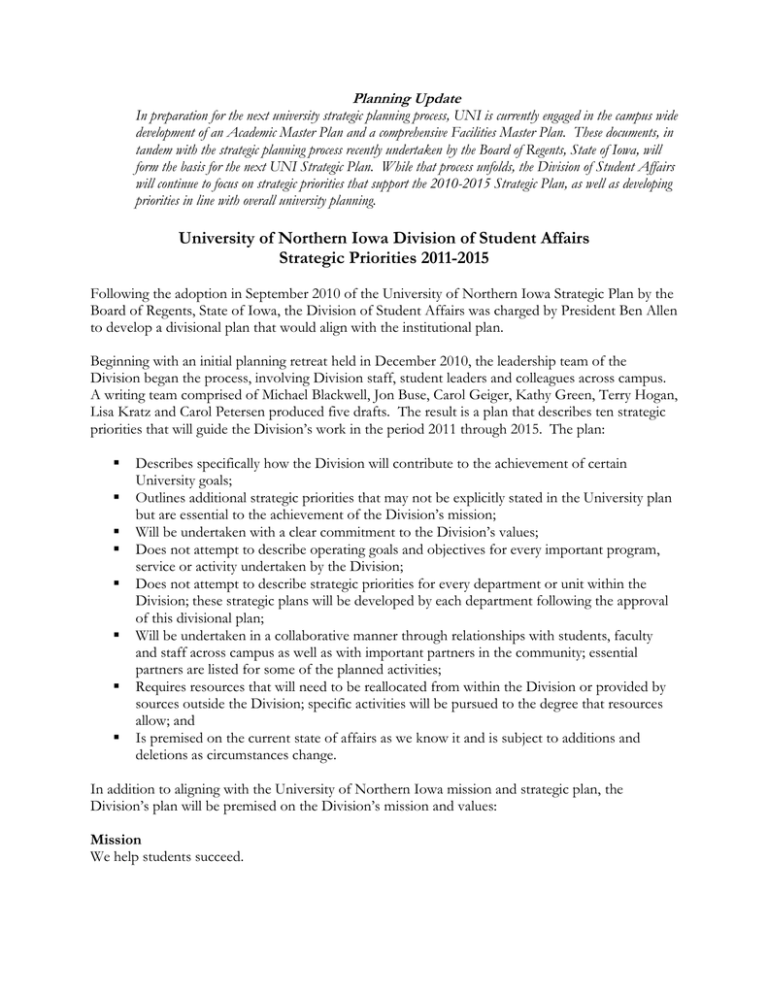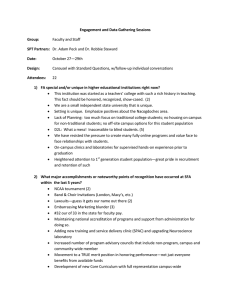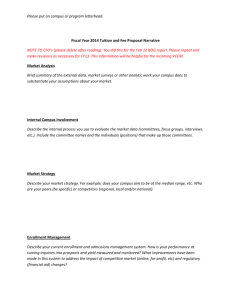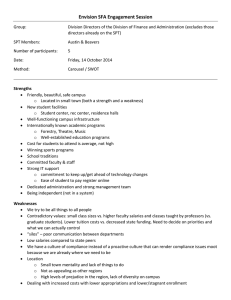Planning Update
advertisement

Planning Update In preparation for the next university strategic planning process, UNI is currently engaged in the campus wide development of an Academic Master Plan and a comprehensive Facilities Master Plan. These documents, in tandem with the strategic planning process recently undertaken by the Board of Regents, State of Iowa, will form the basis for the next UNI Strategic Plan. While that process unfolds, the Division of Student Affairs will continue to focus on strategic priorities that support the 2010-2015 Strategic Plan, as well as developing priorities in line with overall university planning. University of Northern Iowa Division of Student Affairs Strategic Priorities 2011-2015 Following the adoption in September 2010 of the University of Northern Iowa Strategic Plan by the Board of Regents, State of Iowa, the Division of Student Affairs was charged by President Ben Allen to develop a divisional plan that would align with the institutional plan. Beginning with an initial planning retreat held in December 2010, the leadership team of the Division began the process, involving Division staff, student leaders and colleagues across campus. A writing team comprised of Michael Blackwell, Jon Buse, Carol Geiger, Kathy Green, Terry Hogan, Lisa Kratz and Carol Petersen produced five drafts. The result is a plan that describes ten strategic priorities that will guide the Division’s work in the period 2011 through 2015. The plan: Describes specifically how the Division will contribute to the achievement of certain University goals; Outlines additional strategic priorities that may not be explicitly stated in the University plan but are essential to the achievement of the Division’s mission; Will be undertaken with a clear commitment to the Division’s values; Does not attempt to describe operating goals and objectives for every important program, service or activity undertaken by the Division; Does not attempt to describe strategic priorities for every department or unit within the Division; these strategic plans will be developed by each department following the approval of this divisional plan; Will be undertaken in a collaborative manner through relationships with students, faculty and staff across campus as well as with important partners in the community; essential partners are listed for some of the planned activities; Requires resources that will need to be reallocated from within the Division or provided by sources outside the Division; specific activities will be pursued to the degree that resources allow; and Is premised on the current state of affairs as we know it and is subject to additions and deletions as circumstances change. In addition to aligning with the University of Northern Iowa mission and strategic plan, the Division’s plan will be premised on the Division’s mission and values: Mission We help students succeed. We help students prepare for responsible citizenship, personal fulfillment, and success in life by supporting their efforts to learn through their experiences, achieve their academic goals, and strive for excellence in all. We do this by: Developing environments that are safe, welcoming, inclusive and healthy; Providing services that are professional, supportive and personalized; and Fostering meaningful student engagement in campus and community life that develops leadership, educates about diversity, and contributes to learning. Values In seeking to accomplish this mission, we are committed to: Encouraging the development of the whole student and involving all students in the life of the University; Cultivating a caring and diverse campus community that values respect for all people, the open and free exchange of ideas, and responsible and ethical behavior; Maximizing our effectiveness through responsible stewardship of resources, support of innovation, and creativity in problem solving; and Working collaboratively across campus and community, and fostering a work environment for our staff which encourages continuous improvement and professional development. University of Northern Iowa Division of Student Affairs Strategic Priorities 2011-15 Consistent with university and divisional missions and values and in a manner that supports the achievement of goals of the University of Northern Iowa Strategic Plan, the Division of Student Affairs will pursue achievement of goals and objectives supportive of these strategic priorities: Strategic Priority 1: Student success – In close collaboration with Academic Affairs and its units, make significant contributions to the achievement of institution-wide goals to improve retention and graduation rates. 1.1 Determine new strategies and tactics for improving student learning and success, and contribute to their successful implementation. 1.2 Implement recommendations of the Retention Council in order to reduce the gap in retention rates that exists between student groups, based on race and ethnicity. 1.3 Conduct initial assessment of student service needs of distance learners and determine the degree to which there are unmet needs; if there are unmet needs, identify possible approaches to meeting them. 1.4 Expand faculty participation in the MAP-Works program and evaluate program effectiveness in improving first year student retention. 1.5 Complete the Foundations of Excellence self-study of the transfer student experience and contribute to implementation of resulting recommendations. 1.6 Expand availability and improve delivery of assistive technology, classroom accommodation, alternate format texts and alternative testing services to improve success of students with disabilities. Strategic Priority 2: Student engagement – Increase the degree to which students, broadly and by subgroup, are positively engaged in campus life and activities. 2.1 Develop strategies to more intentionally foster positive student engagement in campus life through student organization participation, student employment, volunteer community service and service-learning. 2.2 Expand availability of and student participation in internships. 2.3 Explore potential of a web-based portfolio of co-curricular experience as a tool for encouraging and documenting student engagement. 2.4 Develop and implement a more sustainable approach to using anchor weekends to successfully cluster programs and provide a richer campus life experience on weekends. 2.5 Improve the quality and expand the availability of outdoor recreation space to meet growing demand for intramural and sport club participation. 2.6 Complete renovation of Maucker Union Old Central Ballroom to meet growing demand for major events usage. 2.7 Complete the planning, construction and marketing of the new apartment complex and achieve budgeted occupancy rate to meet changing needs and growing demand for oncampus living. Strategic Priority 3: Student recruitment – Develop and implement improved student recruitment strategies to ensure enrollment is sufficient to meet the university goal of 14,000 by fall 2015. 3.1 Develop and implement targeted initiatives to increase enrollment. 3.1.1 Increase international enrollment to 900 by fall 2015 [in collaboration with International Programs]. 3.1.2 Increase multicultural enrollment to 8.5% of overall enrollment by 2015 [in collaboration with Multicultural Recruitment Team and Diversity Council]. 3.1.3 Increase non-resident enrollment by replicating regionally-based recruitment and Good Neighbor programs. 3.1.4 Increase transfer student enrollment by enhancing transfer credit evaluation, articulation and recruitment efforts. 3.2 Develop and implement initial key elements of a coordinated graduate student recruitment marketing and communication effort [in collaboration with Graduate College]. 3.3 Develop joint customized prospect communication programs with select colleges and academic departments using new constituent relationship management (CRM) system of Student Information System (SIS). 3.4 Develop and deploy refined tools for enrollment forecasting, application flow tracking and population-level goal setting [in collaboration with Institutional Research]. 3.5 Assess effectiveness of branding/marketing campaigns and use results to refine future campaigns [in collaboration with University Relations]. 3.6 Contract for professional services to refurbish the Admissions website and complete refurbishment by August 2011. Strategic Priority 4: Diversity – Make substantial contributions to the creation and maintenance of an inclusive educational environment which prepares students to thrive in a diverse, global society. 4.1 Increase the diversity of the student body (see Priority 3: Student recruitment). 4.2 Increase the diversity of the Division’s workforce, including students and graduate assistants. 4.3 Develop and implement strategies to increase positive interaction between students who are different from each other. 4.4 Improve rates of participation by majority students in existing programs and activities intended to educate about diversity. 4.5 Increase the number and improve the quality of relationships between Division departments and student organizations and student leaders that support diverse populations; assess needs and provide greater level of support. 4.6 Assess needs and develop plans to support LGBT students. 4.7 Improve rates of success for students who are in the minority (see Priority 1: Student success). 4.8 Support planning and implementation of the institution-wide “Reaching for Higher Ground” effort. 4.9 Prioritize facilities, programs and services within the Division for accessibility audits; complete audits and develop improvement plans (see Priority 1: Student success). 4.10 Appoint a coordinator of veterans student services and act on additional recommendations of the Veterans Student Services Committee. Strategic Priority 5: Affordability -- Refine efforts to provide students a greater degree of affordability. 5.1 Improve clarity, utility and accessibility of information about financial aid to students and their families. 5.2 Educate students about responsible and effective money management; evaluate effectiveness of current financial literacy efforts and refine as needed. 5.3 Continue shifting available institutional aid dollars to students with demonstrated financial need. 5.4 Evaluate and refine business processes across units in order to reduce the cost of providing programs and services. Strategic Priority 6: Sustainability – Educate students and staff, and encourage reduction in energy consumption and adoption of other sustainability practices. 6.1 Retrofit lighting systems in major facilities to reduce energy consumption – Wellness and Recreation Center, Department of Residence facilities and Maucker Union. 6.2 Increase rate of recycling in facilities and spaces for which Division has responsibility; encourage students to recycle in off-campus housing. 6.3 Seek Leadership in Energy and Environmental Design (LEED) certification for apartment complex under construction. 6.4 Determine, prioritize and implement cost effective strategies for decreasing carbon footprint of dining operations. 6.5 Implement paperless workflow for key business processes in order to reduce costs and consumption of materials/energy. 6.6 Install ultraviolet systems in swimming pools to improve safety and reduce reliance on chlorine. Strategic Priority 7: Communication – Improve communication to constituents about important issues and ideas. 7.1 Create and deploy a system of routine communication to and education of faculty and staff on high-priority student matters [in collaboration with Academic Affairs]. 7.2 Leverage digital communication strategies to encourage greater student participation and engagement in campus life and support greater communication across the Division. 7.3 Develop an approach to more routine communication with formal and informal student leaders. 7.4 Assess current degree of accessibility of Division websites and implement plan for improvement. 7.5 Assess communication and information needs of staff in the Division and implement improvements. Strategic Priority 8: Professional development – Expand support for staff professional development. 8.1 Conduct initial staff needs assessment (including student staff) and determine plan for implementation of selected approaches. 8.2 Bolster partnership with Postsecondary Education: Student Affairs, Health, Physical Education and Leisure Services (HPELS) and other graduate programs as appropriate in order to recruit quality graduate staff and nurture future professionals. Strategic Priority 9: Risk reduction -- Reduce risk associated with Division facilities, programs and services. 9.1 Participate in institution-wide Risk Management Council and implement recommendations that result from its work. 9.2 Review and update key policies – alcohol, food, student records, space use, Health Insurance Portability and Accountability Act (HIPAA), emergencies and video cameras. 9.3 Create and deploy a system of routine communication to and education of faculty and staff on student matters with known risk (e.g., discipline, disruption, mental health, harassment, discrimination, bias, sexual misconduct, disability accommodation, emergency response); pursue efforts to the degree possible as part of an institution-wide collaborative approach (see Priority 7: Communication). 9.4 Review current efforts and alter as needed to ensure continued compliance with applicable federal regulations (e.g., Higher Education Opportunity Act and Title IX). 9.5 Continue infrastructure improvements in residence facilities 9.5.1 Continue project to provide sprinkler coverage in residence halls on campus. 9.5.2 Assess need for video camera placement within residence halls on campus. 9.5.3 Assess needs and possible solutions to electronic building access [in collaboration with Administration and Financial Services]. 9.6 Refine and improve continuity of operations plans, particularly those related to information technology. 9.7 Review existing policies and practices related to managing campus events and develop plan for improvement. Strategic Priority 10: Student information system – Ensure complete and effective implementation of new student information system. 10.1 Ensure improved decision support systems related to recruitment goal setting, application tracking and enrollment forecasting [in collaboration with Institutional Research]. 10.2 Develop and implement strategy to maximize access to Student Information System (SIS)related data via warehouse [in collaboration with Information Technology Services]. 10.3 Clarify and improve systems for internal and external reporting [in collaboration with Institutional Research]. 10.4 Maximize potential of constituent relationship management (CRM) system to enhance communication with prospective and current students and increase enrollment and retention (see Priority 3: Student recruitment). 10.5 Develop strategy and operational plans for post-implementation maintenance and continued enhancement [in collaboration with Information Technology Services]. 10.6 Ensure that departments reliant on SIS have sufficient training and support to meet obligations associated with the system. 10.7 Develop and implement strategy to use imaging to maximize access to electronic documents. Adopted by Division Leadership Team – April 27, 2011


